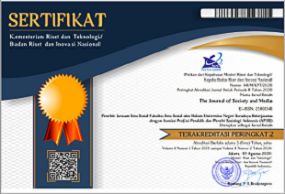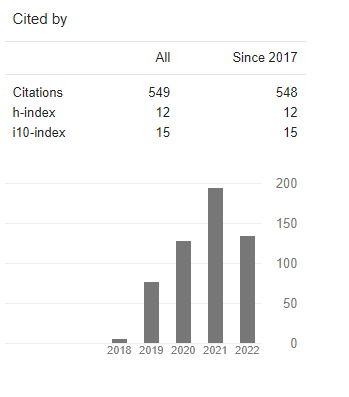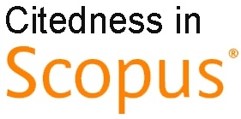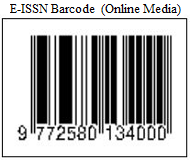Environmental Communication in Social Media: A Bibliometric Study of Climate Change Discourse and Public Engagement
DOI:
https://doi.org/10.26740/jsm.v9n1.p203-240Keywords:
bibliometrix, biblioshiny, climate change, public engagement, communication.Abstract
This study uses bibliometric analysis based on the Biblioshiny application in R Programming to explore climate change discourse in social media. Data were obtained from Scopus from 2008-2024, resulting in 57 scientific articles that were analyzed to explore research trends, lead author contributions, collaboration networks, information sources, and country of origin. The study provides an overview of the dataset, publication trends, citations, author profiles, journal analysis, country distribution, and research themes. Using a bibliometric approach, it aims to analyze the evolution of climate change discourse and enhance communication policies on social media. The results show a significant increase in publications each year, with a peak in 2024 High-impact articles by Koteyko N., Jaspal R., and Nerlich B. are key references. The U.S. and U.K. lead in publications and global scientific influence, while developing countries' contributions are lacking, emphasizing the need for international collaboration to enhance global representation in research. Key journals like Science Communication and Geographical Journal are vital for disseminating research on themes such as climate change, social media, and communication. Notable research areas include sentiment analysis, social networks, and environmental management, offering insights that can aid in developing inclusive and sustainable communication policies.
References
Abdullah, K. H. 2023. "An Analysis of Publications on Climate Change Communication Using a Bibliometric Lens." Fronteiras: Journal of Social, Technological and Environmental Science 12(3):354–71. doi: https://doi.org/10.21664/2238-8869.2023v12i3.p354-371.
Afandi, Murni, O. P., and E. N. A. Dewi. 2024. "Artificial Intelligence Research Trends in Education: Bibliometric Analysis Using Biblioshiny." Educate: Jurnal Teknologi Pendidikan 9(1):1–18. doi: https://doi.org/10.32832/educate.v9i1.15376.
Ainurrohmah, S., and S. Sudarti. 2022. "Analisis Perubahan Iklim dan Global Warming yang Terjadi sebagai Fase Kritis." Phi: Jurnal Pendidikan Fisika dan Terapan 8(1):1–10. doi: https://doi.org/10.22373/p-jpft.v8i1.13359.
Alsharif, A., N. Salleh, and R. Baharun. 2020. "Research Trends of Neuromarketing: A Bibliometric Analysis." Journal of Theoretical and Applied Information Technology 98:2948–62. Retrieved April 24, 2025 (https://www.jatit.org/volumes/Vol98No15/6Vol98No15.pdf).
Amano, Tatsuya, Veronica Berdejo-Espinola, Alison P. Christie, Katie Willott, Masashi Akasaka, András Báldi, Amanda Berthinussen, Sandro Bertolino, Alexander J. Bladon, Ming Chen, Chang-Yong Choi, Magda Bou Dagher Kharrat, Lúcia G. de Oliveira, Pascale Farhat, Maksym Golivets, Natalia Hidalgo Aranzamendi, Katrin Jantke, Joanna Kajzer-Bonk, Meryem Ç.
Kemahlı Aytekin, … William J. Sutherland. 2021. "Tapping into Non- English-Language Science for the Conservation of Global Biodiversity." PLOS Biology 19(10):e3001296. doi: https://doi.org/10.1371/journal.pbio.3001296.
Audu, L. O. 2024. "Examining the Effectiveness of Indigenous Language in Climate Change Communication in Selected Communities of Federal Capital Territory, Abuja, Nigeria." Adamawa State University Journal of Scientific Research 12(1):48–54. Retrieved April 24, 2025 (https://adsujsr.adsu.edu.ng/wp-content/uploads/2024/07/VOL12-1- 06.pdf).
Bahji, A., L. Acion, Anne-Marie Laslett, and Bryon Adinoff. 2023. "Exclusion of the Non-English-Speaking World from the Scientific Literature: Recommendations for Change for Addiction Journals and Publishers." Nordic Studies on Alcohol and Drugs 40(1):6–13. doi: https://doi.org/10.1177/14550725221102227.
Bera, M., S. Das, S. Dutta, and M. Roy Choudhury. 2025. “Navigating the Future: Climate Change Impacts, Mitigation Strategies, and Adaptation Pathways in Agriculture.” Pp. 419–443 in Ecologically Mediated Development: Promoting Biodiversity Conservation and Food Security. doi: 10.1007/978- 981-96-2413-3_19.
Berglez, Peter, and Ulrika Olausson. 2023. “Climate Irresponsibility on Social Media. A Critical Approach to ‘High-Carbon Visibility Discourse.’” Social Semiotics 33(5):1011–25. doi: 10.1080/10350330.2021.1976053.
Boehm, S., and C. Schumer. 2023. “10 Big Findings from the 2023 IPCC Report on Climate Change.” Power a Sustainable Future For Earth Month, Help Us Create a Healthier, More Hopeful Planet. Retrieved April 24, 2025 (https://www.wri.org/insights/2023-ipcc-ar6-synthesis-report-climate- change-findings).
Casiraghi, L., E. Kim, and N. Hara. 2024. “Tweeting on Thin Ice: Scientists in Dialogic Climate Change Communication with the Public.” First Monday
29(6). doi: 10.5210/fm.v29i6.13543.
Cherry, C., C. Verfuerth, and C. Demski. 2024. “Discourses of Climate Inaction Undermine Public Support for 1.5 °C Lifestyles.” Global Environmental Change 87:102875. doi: 10.1016/j.gloenvcha.2024.102875.
Cooper, A. K., and S. Coetzee. 2020. “On the Ethics of Using Publicly-Available Data.” Pp. 159–171 in Responsible Design, Implementation and Use of
Information and Communication Technology. doi: 10.1007/978-3-030- 45002-1_14.
Davoudi, S., and R. Machen. 2022. “Climate Imaginaries and the Mattering of the Medium.” Geoforum 137:203–12. doi: 10.1016/j.geoforum.2021.11.003.
Donthu, N., S. Kumar, D. Mukherjee, N. Pandey, and W. M. Lim. 2021. “How to Conduct a Bibliometric Analysis: An Overview and Guidelines.” Journal of Business Research 133:285–96. doi: 10.1016/j.jbusres.2021.04.070.
Faraji, O., K. Asiaei, Z. Rezaee, N. Bontis, and E. Dolatzarei. 2022. “Mapping the Conceptual Structure of Intellectual Capital Research: A Co-Word Analysis.” Journal of Innovation & Knowledge 7(3):100202. doi: 10.1016/j.jik.2022.100202.
Fathiyah, U. 2023. “Strategi Komunikasi Publik Dinas Lingkungan Hidup dan Kehutanan Provinsi Riau dalam Menyampaikan Informasi Perubahan Iklim.” Universitas Islam Negeri Sultan Syarif Kasim Riau.
Foderaro, A., and D. G. Lorentzen. 2023. “Argumentative Practices and Patterns in Debating Climate Change on Twitter.” Aslib Journal of Information Management 75(1):131–48. doi: 10.1108/AJIM-06-2021-0164.
Freedman, A. 2021. “Biden’s Climate Communications Challenge.” Axios. Retrieved April 24, 2025 (https://www.axios.com/2021/08/13/biden- climate-policy-communications-challenge-ipcc).
Gokcimen, T., and B. Das. 2024. “Exploring Climate Change Discourse on Social Media and Blogs Using a Topic Modeling Analysis.” Heliyon 10(11):e32464. doi: 10.1016/j.heliyon.2024.e32464.
Gourikeremath, G., R. Hiremath, and G. Hadagali. 2021. “Application of Bradford’s Law to the Scientific Literature of Two UPE (University with Potential for Excellence) Status Universities of India: A Study Based on the Web of Science Database.” J. Adv. Lib. Inform. Sci 10:160–65.
Horn-Muller, A. 2023. “AI Is Shattering Climate Language Barriers.” Axios. Retrieved April 24, 2025 (https://www.axios.com/2023/06/06/ai-language- barriers-climate).
Huang, J.-H., X.-Y. Duan, F.-F. He, G.-J. Wang, and X.-Y. Hu. 2021. “A Historical Review and Bibliometric Analysis of Research on Weak Measurement Research over the Past Decades Based on Biblioshiny.” ArXiv Preprint. doi: 10.48550/arXiv.2108.11375.
Intergovernmental Panel on Climate Change. 2023. AR6 Synthesis Report: Climate
Change. IPCC. Retrieved April 24, 2025
(https://www.ipcc.ch/report/ar6/syr/).
Kah, M., A. Kargbo, P. A. Mendy, E. Jawo, and E. Mendy. 2021. “Awareness of the Causes, Impact and Solutions to Global Warming among Undergraduate Students from Different Schools in the University of The Gambia.” Ghana Journal of Geography 13(3). doi: 10.4314/gjg.v13i3.12.
Karakose, T., T. Tülübaş, S. Papadakis, and R. Yirci. 2023. “Evaluating the Intellectual Structure of the Knowledge Base on Transformational School Leadership: A Bibliometric and Science Mapping Analysis.” Education Sciences 13(7):708. doi: 10.3390/educsci13070708.
Lestari, R., A. Nurmandi, M. Younus, H. Lawelai, and W. Suardi. 2025. “Optimizing Social Media Platforms to Foster Active Public Engagement in Tackling Climate Change and Environmental Conservation.” Society 13(1):18–34. doi: 10.33019/society.v13i1.742.
Machmud, W. S., E. Nurbayani, and S. Ramadhan. 2023. “Analisis Bibliometrik Kemampuan Berpikir Kritis Menggunakan R Package.” Judika (Jurnal Pendidikan Unsika) 11(1):45–68. doi: 10.35706/judika.v11i1.8582.
Mairita, P., A. Afandi, and E. S. Wahyuni. 2024. “Tren Topik Attention Deficit Hyperactivity Disorder (ADHD): Analisis Bibliometrik Menggunakan Biblioshiny.” DWIJA CENDEKIA: Jurnal Riset Pedagogik 8(2):322. doi: 10.20961/jdc.v8i2.90153.
Markowitz, D. M. 2024. “From Complexity to Clarity: How AI Enhances Perceptions of Scientists and the Public’s Understanding of Science.” ArXiv Preprint. doi: 10.48550/arXiv.2405.00706.
Masullo, G. M., T. Wilner, and N. J. Stroud. 2022. “What Social Media Could Be: Normative Frameworks for Evaluating Digital Public Spaces.” Social Media + Society 8(4). doi: 10.1177/20563051221130447.
Milstein, T., and G. Mocatta. 2022. “Environmental Communication Theory and Practice for Global Transformation: An Ecocultural Approach.” Pp. 474– 490 in The Handbook of Global Interventions in Communication Theory. Routledge.
Mooseder, A., C. Brantner, R. Zamith, and J. Pfeffer. 2023. “(Social) Media Logics and Visualizing Climate Change: 10 Years of #climatechange Images on Twitter.” Social Media + Society 9(1). doi: 10.1177/20563051231164310.
Moser, S. C. 2010. “Communicating Climate Change: History, Challenges, Process and Future Directions.” WIREs Climate Change 1(1):31–53. doi: 10.1002/wcc.11.
Nanda, S. S., O. Samba, and A. Sahide. 2021. “Inequity in International Climate Change Negotiations.” Nation State: Journal of International Studies 4(2):153–77. doi: 10.24076/nsjis.v4i2.444.
Nuraini, I., and Thuba Jazil. 2023. “A Biblioshiny Application Using R on Zakat Index.” Islamic Economics Methodology 2(1). doi: 10.58968/iem.v2i1.163.
Nursal, A. T., M. F. Omar, M. N. M. Nawi, M. S. Khalid, and N. A. M. Zaki. 2024. “Online Reviews Sentiment Analysis Based on High-Rise Residential Projects in Malaysia.” Journal of Electrical Systems 20(3s):257–66. doi: 10.52783/jes.1282.
O’Neill, S., and S. Nicholson-Cole. 2009. “‘Fear Won’t Do It.’” Science Communication 30(3):355–79. doi: 10.1177/1075547008329201.
Oramah, C. P., T. A. Ngwu, and C. N. Odimegwu. 2025. “Addressing the Impact of Complex English Use in Communicating Climate Change in Nigerian Communities Through Contextual Understanding.” Climate 13(3):56. doi: 10.3390/cli13030056.
Padilla-Castillo, G., and J. Rodríguez-Hernández. 2022. “International Youth Movements for Climate Change: The #FridaysForFuture Case on Twitter.” Sustainability 15(1):268. doi: 10.3390/su15010268.
Passas, I. 2024. “Bibliometric Analysis: The Main Steps.” Encyclopedia 4(2):1014–
25. doi: 10.3390/encyclopedia4020065.
Pera, A., and L. M. Aiello. 2024. “Shifting Climates: Climate Change Communication from YouTube to TikTok.” ACM Web Science Conference:376–81. doi: 10.1145/3614419.3644024.
Prokopowicz, D., and A. Gołębiowska. 2021. “Increase in the Internetization of Economic Processes, Economic, Pandemic and Climate Crisis as Well as Cybersecurity as Key Challenges and Philosophical Paradigms for the Development of the 21st Century Civilization.” Journal of Modern Science 47(2):307–44. doi: 10.13166/jms/143848.
Rahimi, M. 2020. “Public Awareness: What Climate Change Scientists Should Consider.” Sustainability 12(20):8369. doi: 10.3390/su12208369.
Rajanen, D. 2021. “Interactive and Participatory Media for Public Engagement with Climate Change: A Systematic Literature Review and an Integrative
Model.” In Interact 5. University of Oulu.
Repke, T., M. Callaghan, W. F. Lamb, S. Lück, F. Müller-Hansen, and J. C. Minx. 2024. “How Global Crises Compete for Our Attention: Insights from 13.5 Million Tweets on Climate Change during COVID-19.” Energy Research & Social Science 116:103668. doi: 10.1016/j.erss.2024.103668.
Sorce, G., and D. Dumitrica. 2023. “From School Strikes to Webinars: Mapping the Forced Digitalization of Fridays for Future’s Activism during the COVID-19 Pandemic.” Convergence: The International Journal of Research into New Media Technologies 29(3):570–85. doi: 10.1177/13548565221148112.
Thanya, R., and S. C. 2023. “Environmental Behaviour and Climate Change Promotion Impact via Social Media Platforms: A Review.” Environment and Ecology Research 11(5):760–67. doi: 10.13189/eer.2023.110506.
Thelwall, M., K. Kousha, E. Stuart, M. Makita, M. Abdoli, P. Wilson, and J. Levitt. 2023. “In Which Fields Are Citations Indicators of Research Quality?” Journal of the Association for Information Science and Technology 74(8):941–53. doi: 10.1002/asi.24767.
van der Linden, S., J. Roozenbeek, and J. Compton. 2020. “Inoculating Against Fake News About COVID-19.” Frontiers in Psychology 11. doi: 10.3389/fpsyg.2020.566790.
Wang, X., J. Lu, Z. Song, Y. Zhou, T. Liu, and D. Zhang. 2022. “From Past to Future: Bibliometric Analysis of Global Research Productivity on Nomogram (2000–2021).” Frontiers in Public Health 10. doi: 10.3389/fpubh.2022.997713.
Wang, Z., Y. Song, and Z. Chen. 2023. “Tracing the Flow of Climate Change Frames: Intermedia Agenda Setting Between Twitter and News Media in the US and the UK.” Emerging Media 1(2):244–68. doi: 10.1177/27523543231218296.
Wani, Z. A., F. Akhter, Q. Ridwan, Y. S. Rawat, Z. Ahmad, and S. Pant. 2023. “A Bibliometric Analysis of Studies on Plant Endemism during the Period of 1991–2022.” Journal of Zoological and Botanical Gardens 4(4):692–710. doi: 10.3390/jzbg4040049.
Widhagdha, M. F., W. Muktiyo, D. T. Kartono, and D. Padmaningrum. 2025. “Communicating Climate Change: The Role of Nature-Based Community Development Program in Enhancing Stakeholders Engagement.” BIO Web
of Conferences 155:06014. doi: 10.1051/bioconf/202515506014.
Yang, F., J. Gao, and X. Kan. 2024. “Biblioshiny-R Application on Bioinformatics Education Research (2004–2023).” Curriculum and Teaching Methodology
7(8). doi: 10.23977/curtm.2024.070829.
Downloads
Published
How to Cite
Issue
Section
License
Copyright (c) 2025 The Journal of Society and Media

This work is licensed under a Creative Commons Attribution 4.0 International License.
 Abstract views: 751
,
Abstract views: 751
, PDF Downloads: 515
PDF Downloads: 515












